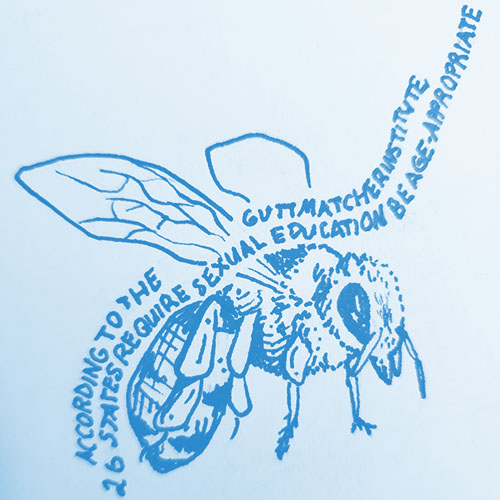
Graphic by Emmanuelle Copeland
The Bees.
Building the foundation of age-appropriate lessons
The implementation of sexual education programs within the learning environment does not begin in a high school setting. Students are taught lessons concerning sexual education and puberty as early as elementary school.
Health and physical education teacher Heather Petersen, who works at Eisenhower Jr. High, incorporates a three-week sexual education unit into the yearly health curriculum.
“There is an emphasis on the relationship between the menstrual cycle and fertilization. We also cover the pregnancy process and after pregnancy. We discuss the impact STD’s/ STI’s have on males and females and how easy [they are] spread and how common [they] actually [are],” Petersen said.
Petersen explained that the unit encourages the practice of abstinence. It also goes in depth about the importance of both developing and building healthy relationships within partnerships.
Robert Crown is billed as a “health education center” in the Chicagoland area that many elementary and middle schools in the area reach out to. According to their website, the association has been teaching students for over 40 years and will educate their six millionth student this year. The Robert Crown organization believes it is important to start by introducing a simple basis of understanding, and build upon that foundation into more in-depth discussions as students age and mature.
“Just like students need to understand addition before algebra, it’s important to learn the basics of health education before moving to more complex topics, ” robertcrown.org said.
Students in grades four and five are instructed on puberty education, while grades six and seven participate in a program titled “Life Begins,” which teaches reproductive science. In seventh and eighth grade, growing adolescents are exposed to the teen sexual health program.
Back to classroom programs and instruction, sophomore Nick Schmidt-Bailey recalled the sexual education he received at O’Neill Middle School.
“In my opinion, the sex-ed program teaches the anatomy of the body well. However, the sex-ed courses do not teach … well, sex. … It still seems afraid to talk about serious topics that need to be spoken about,” Schmidt-Bailey said.
On the other hand, freshman Abby Knight, believed the sexual education unit she participated in at Eisenhower Jr. High was a beneficial experience that she is grateful for.
“My middle school gym teacher taught our class sex-ed, and I think it was a good experience to learn for the future, and all the questions I remember having were answered,” Knight said.
The teachers and organizations that specialize in the health curriculum believe it is better to begin student instruction on sex-ed sooner rather than later.
“I do feel it is important because we hope to reach them before [they] become sexually active. The content is so important and there is so much false information out there that the students receive. Most importantly, I hope I am able to build a relationship with my classes where they feel comfortable asking questions that they might have instead of assuming they know,” Petersen said.